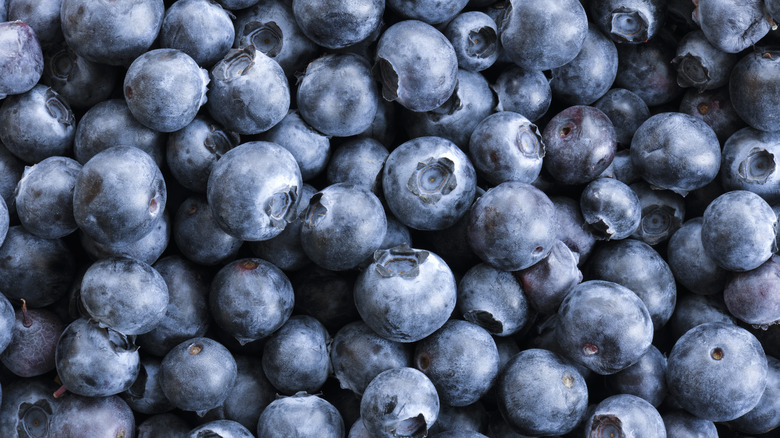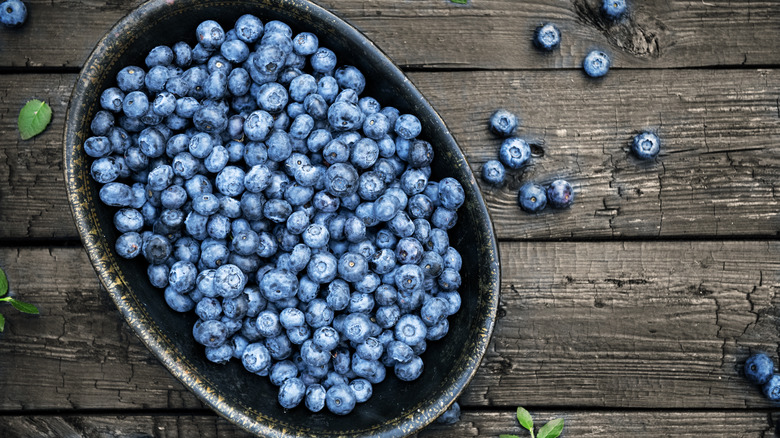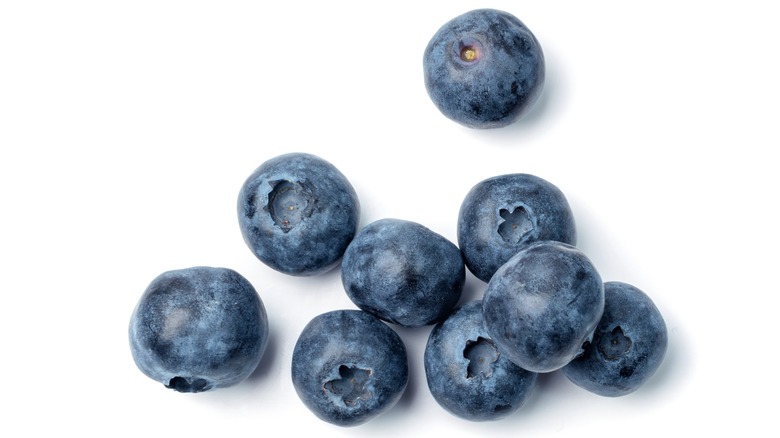How To Choose The Tastiest Blueberries At The Grocery Store
When you're staring at fruit at the grocery store, you're probably trying to remember tricks your parents taught you to see if it's suitable to take home, like thumping a melon to see if it's ripe. There aren't any such tips for fresh blueberries that we can think of, which is a bummer because they're always in season. This is because they're harvested on varying timelines by producers in North and South America. And not only can you enjoy them year-round, but blueberries have been termed a "superfood" by Healthline, due to the fact that they're nutrient dense and packed with antioxidants.
For those who are concerned primarily with flavor, however, there are a few things to keep in mind when shopping for blueberries at the grocery store. The color of the berries, notably, provides abundant clues to how tasty your blueberries are likely to be, whether baked in pies, added to jams, muffins, yogurt, cocktails, barbecue sauce, or simply enjoyed as a solo snack. Size, on the other hand, may tell you something about how the blueberries were grown, but it's not an important factor at all when it comes to taste.
With that in mind, here's everything you need to know about picking out the tastiest blueberries.
Why color is the most important factor in choosing blueberries
They're called blueberries for a reason; that's the color they turn when ripe. Unripened blueberries, by contrast, are often distinguished by a white or green hue. Reddish or pinkish-blue colors, meanwhile, indicate the berries are almost ripe. But almost ripe isn't nearly good enough when it comes to optimal flavor. Why? Because blueberries don't continue to ripen after being picked. As a consequence, berries that are picked too soon will lack the distinctive sweetness associated with fully ripe fruit.
The ripest and tastiest berries are those that are blue, or bluish-purple, but with a light dusting of white or whitish-gray. The latter is what's known as the "bloom" of blueberries, and as the name suggests, it's a good thing. This coating develops on the berries to protect them from intense sunlight, and its presence is a sure indicator that they're ripe, sweet, and ready to eat.
All that being said, color is the most important factor when shopping for blueberries. One should confirm the berries have the correct color, as well as a noticeable bloom, before purchasing them. But other factors also come into play, including the blueberries' texture, and the manner in which they've been packaged.
Other factors to pay attention to when shopping for blueberries
Texture, like color, is a good indicator of a blueberry's ripeness level. The ripest berries are firm to the touch, and a little plump. This plumpness should not be associated with size, however, since size in blueberries is a reflection of the variety. There are five of note in the U.S., including lowbush and highbush types — which refers to the relative amount of water the berries received during the growing process.
Overripe berries, by contrast, can be either wrinkled or overly mushy. Mold is another symptom to look for, and one which can be exacerbated by faulty packaging. Ventilated packaging is the best, so if you see blueberries have been packaged without air holes, there's a good chance of mold developing.
Once you've picked out the right blueberries, proper storage is also important in terms of preserving flavor and freshness. They should be refrigerated immediately, of course, after you've removed any individual berries showing signs of damage, whether that's shrinkage, mushiness, or mold. Washing blueberries is also a good idea, but this shouldn't be done until you're ready to prepare or consume them. Otherwise, this process will negatively impact texture and freshness. When properly stored, blueberries should retain maximum flavor and freshness for up to a week.



